Related Research Articles

The Second Amendment to the United States Constitution protects the right to keep and bear arms. It was ratified on December 15, 1791, along with nine other articles of the Bill of Rights. In District of Columbia v. Heller (2008), the Supreme Court affirmed for the first time that the right belongs to individuals, for self-defense in the home, while also including, as dicta, that the right is not unlimited and does not preclude the existence of certain long-standing prohibitions such as those forbidding "the possession of firearms by felons and the mentally ill" or restrictions on "the carrying of dangerous and unusual weapons". In McDonald v. City of Chicago (2010) the Supreme Court ruled that state and local governments are limited to the same extent as the federal government from infringing upon this right. New York State Rifle & Pistol Association, Inc. v. Bruen (2022) assured the right to carry weapons in public spaces with reasonable exceptions.

Gun politics is defined in the United States by two primary opposing ideologies concerning the private ownership of firearms. Those who advocate for gun control support increasingly restrictive regulation of gun ownership; those who advocate for gun rights oppose increased restriction, or support the liberalization of gun ownership. These groups typically disagree on the interpretation of the text, history and tradition of the laws and judicial opinions concerning gun ownership in the United States and the meaning of the Second Amendment to the Constitution of the United States. American gun politics involves these groups' further disagreement concerning the role of firearms in public safety, the studied effects of ownership of firearms on public health and safety, and the role of guns in national and state crime.
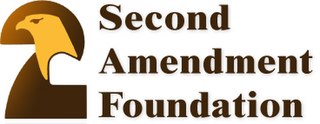
The Second Amendment Foundation (SAF) is a United States nonprofit organization that supports gun rights. Founded in 1974 by Alan Gottlieb and headquartered in Bellevue, Washington, SAF publishes gun rights magazines and public education materials, funds conferences, provides media contacts, and has assumed a central role in sponsoring lawsuits.
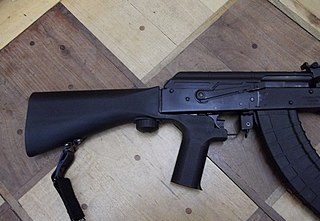
Bump stocks or bump fire stocks are gun stocks that can be used to assist in bump firing. Bump firing is the act of using the recoil of a semi-automatic firearm to fire ammunition cartridges in rapid succession.

In the United States, open carry refers to the practice of visibly carrying a firearm in public places, as distinguished from concealed carry, where firearms cannot be seen by the casual observer. To "carry" in this context indicates that the firearm is kept readily accessible on the person, within a holster or attached to a sling. Carrying a firearm directly in the hands, particularly in a firing position or combat stance, is known as "brandishing" and may constitute a serious crime, but is not the mode of "carrying" discussed in this article.
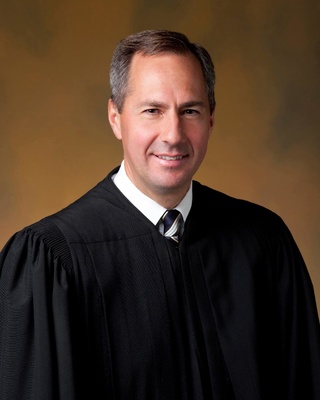
Thomas Michael Hardiman is a United States circuit judge of the United States Court of Appeals for the Third Circuit. Nominated by President George W. Bush, he began active service on April 2, 2007. He maintains chambers in Pittsburgh, Pennsylvania, and was previously a United States district judge.
In the United States, the right to keep and bear arms is modulated by a variety of state and federal statutes. These laws generally regulate the manufacture, trade, possession, transfer, record keeping, transport, and destruction of firearms, ammunition, and firearms accessories. They are enforced by state, local and the federal agencies which include the Bureau of Alcohol, Tobacco, Firearms and Explosives (ATF).
District of Columbia v. Heller, 554 U.S. 570 (2008), is a landmark decision of the Supreme Court of the United States. It ruled that the Second Amendment to the U.S. Constitution protects an individual's right to keep and bear arms—unconnected with service in a militia—for traditionally lawful purposes such as self-defense within the home, and that the District of Columbia's handgun ban and requirement that lawfully owned rifles and shotguns be kept "unloaded and disassembled or bound by a trigger lock" violated this guarantee. It also stated that the right to bear arms is not unlimited and that certain restrictions on guns and gun ownership were permissible. It was the first Supreme Court case to decide whether the Second Amendment protects an individual right to keep and bear arms for self-defense or whether the right was only intended for state militias.
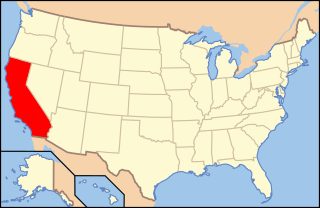
Gun laws in California regulate the sale, possession, and use of firearms and ammunition in the state of California in the United States.
McDonald v. City of Chicago, 561 U.S. 742 (2010), was a landmark decision of the Supreme Court of the United States that found that the right of an individual to "keep and bear arms", as protected under the Second Amendment, is incorporated by the Fourteenth Amendment and is thereby enforceable against the states. The decision cleared up the uncertainty left in the wake of District of Columbia v. Heller (2008) as to the scope of gun rights in regard to the states.

Gun laws in New York regulate the sale, possession, and use of firearms and ammunition in the U.S. state of New York, outside of New York City which has separate licensing regulations. These regulations are very strict in comparison to the rest of the United States.

Gun laws in the District of Columbia regulate the sale, possession, and use of firearms and ammunition in Washington, D.C..

Gun laws in Illinois regulate the sale, possession, and use of firearms and ammunition in the state of Illinois in the United States.
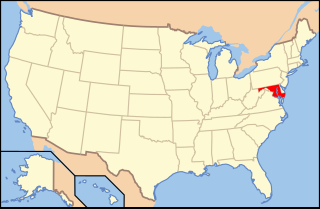
Gun laws in Maryland regulate the sale, possession, and use of firearms and ammunition in the U.S. state of Maryland.

Woollard v. Sheridan, 863 F. Supp. 2d 462, reversed sub. nom., Woollard v Gallagher, 712 F.3d 865, was a civil lawsuit brought on behalf of Raymond Woollard, a resident of the State of Maryland, by the Second Amendment Foundation against Terrence Sheridan, Secretary of the Maryland State Police, and members of the Maryland Handgun Permit Review Board. Plaintiffs allege that the Defendants' refusal to grant a concealed carry permit renewal to Mr. Woollard on the basis that he "...ha[d] not demonstrated a good and substantial reason to wear, carry or transport a handgun as a reasonable precaution against apprehended danger in the State of Maryland" was a violation of Mr. Woollard's rights under the Second and Fourteenth Amendments, and therefore unconstitutional. The trial court found in favor of Mr. Woollard, However, the Fourth Circuit Court of Appeals reversed the trial court and the U.S. Supreme Court declined to review that decision.
People v. Aguilar, 2 N.E.3d 321, was an Illinois Supreme Court case in which the Court held that the Aggravated Unlawful Use of a Weapon (AUUF) statute violated the right to keep and bear arms as guaranteed by the Second Amendment. The Court stated that this was because the statute amounted to a wholesale statutory ban on the exercise of a personal right that was specifically named in and guaranteed by the United States Constitution, as construed by the United States Supreme Court. A conviction for Unlawful Possession of a Firearm (UPF) was proper because the possession of handguns by minors was conduct that fell outside the scope of the Second Amendment's protection.

Peruta v. San Diego, 824 F.3d 919, was a decision of the United States Court of Appeals for the Ninth Circuit pertaining to the legality of San Diego County's restrictive policy regarding requiring documentation of "good cause" that "distinguish[es] the applicant from the mainstream and places the applicant in harm's way" before issuing a concealed carry permit.

A high-capacity magazine is a magazine capable of holding more than the usual number of rounds of ammunition for a particular firearm.
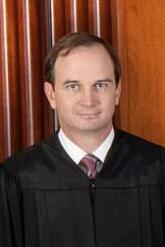
Julius Ness "Jay" Richardson is an American judge and lawyer who serves as a United States circuit judge of the United States Court of Appeals for the Fourth Circuit. He was formerly an Assistant United States Attorney for the District of South Carolina.
New York State Rifle & Pistol Association, Inc. v. City of New York, New York, 590 U.S. ___ (2020), abbreviated NYSRPA v. NYC and also known as NYSRPA I to distinguish it from the subsequent case, was a case addressing whether the gun ownership laws of New York City, which restrict the transport of a licensed firearm out of one's home, violated the Second Amendment to the United States Constitution, the U.S. Constitution's Commerce Clause, and the right to travel. It was the first major gun-related case that the Supreme Court had accepted for review in nearly ten years, after District of Columbia v. Heller (2008) and McDonald v. City of Chicago (2010). After the Supreme Court agreed to hear the case, New York City and New York state amended its laws to allay the challenged provision. In a per curiam decision in April 2020, the Supreme Court determined that the case was moot, vacating and remanding the case to lower courts to determine "whether petitioners may still add a claim for damages in this lawsuit with respect to New York City's old rule".
References
- ↑ "Gun Control Bill In Washington, D.C.", St. Louis Post-Dispatch, June 30, 1976, p. 2D
- ↑ "Government Reform to Review D.C. s Handgun Ban". Congressman Tom Davis. Archived from the original on 2007-02-28. Retrieved 2007-03-09.
- ↑ "Washington Gets Tough Gun Law", St. Louis Post-Dispatch, September 24, 1976, p. 16A
- ↑ "The Case For Reforming The District of Columbia's Gun Laws". National Rifle Association.
- ↑ Senior Circuit Judge Silberman (2007-03-09). "Case No. 04-7041, Parker v. D.C." (PDF). United States Court of Appeals for the District of Columbia Circuit. p. 58. Retrieved 2008-02-12.
Section 7-2507.02, like the bar on carrying a pistol within the home, amounts to a complete prohibition on the lawful use of handguns for self-defense.
- ↑ Kates, Jr. Don B. (1983). "Handgun Prohibition and the Original Meaning of the Second Amendment". Michigan Law Review. 204.
- ↑ Reynolds, Glenn Harlan (1995). "A Critical Guide to the Second Amendment". Tennessee Law Review. 461.
- ↑ Hirschman, Albert O. (1991). The Rhetoric of Reaction: Perversity, Futility, Jeopardy .
- ↑ Polsby, Daniel P. (March 1994). "The False Promise of Gun Control". Atlantic Monthly.
- ↑ Miller, Bill and Robert Barnes (2007-03-09). "Appeals Court Guts D.C. Gun Ban". The Washington Post.
- ↑ "United States: Gun Ownership and the Supreme Court". Library of Congress. Retrieved 7 December 2015.[ dead link ]
- ↑ Nakamura, David (2008-06-26). "D.C. Attorney General: All Guns Must Be Registered". The Washington Post. Archived from the original on 2008-10-11. Retrieved 2008-06-26.